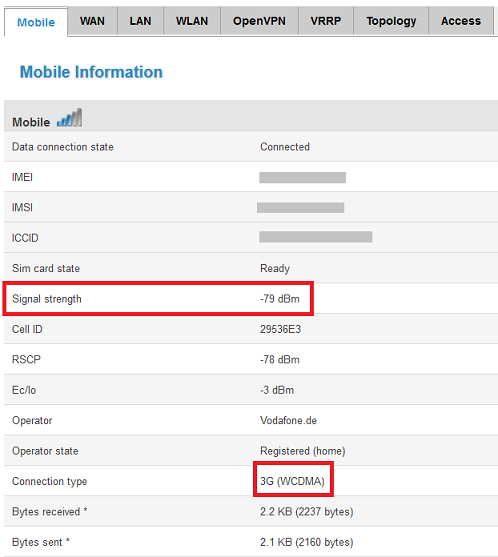To determine the current mobile reception performance for good data transmission, different reception values are relevant depending on the mobile network:
4G mobile network (LTE)
3G mobile network (UMTS / HSPA / HSPA+)
2G mobile network (GPRS / EDGE)
Please note the following:
- The values, colour gradations and comments listed in the tables are empirical values for determining the current reception performance and the possible effects on data transmission. However, the real data transmission may deviate in practical use.
- Data transmission in the mobile network depends not only on mobile reception but also on other factors SIM card tariff, network availability, network load, interference, etc.
4G mobile network (LTE)
The current LTE reception value (RSRP) and LTE signal quality (RSRQ) are relevant for data transmission in the 4G mobile network, see f.e. the hints on the Teltonika Homepage under
https://wiki.teltonika-networks.com/view/RSRP_and_RSRQ or the list below. These reception values can be read out in the cellular router during an LTE connection, see e.g:
mdex MX760 & Advantech router: Status  Mobile WAN
Mobile WAN
Since firmware version 6.2.9 under " More Information " :

Up to firmware version 6.2.8:

MX880: Status  Network: Mobile
Network: Mobile

RSRP
'Reference Signal Received Power' (RSRP) indicates the current
LTE received power value. The determined value is used to select the mobile radio cell and, in mobile use, to hand over to the next radio cell.
| RSRP |
Data transmission |
 |
Data transmission is interference-free. |
| Good data transmission with almost no interference. |
| Data transmission may have slight limitations. |
| Data transmission with limited data throughput, dropouts and aborts are also not excluded. 1 |
| Disturbed data transmission with dropouts, aborts and long packet delays. 1 |
| No connection and no data transmission possible. 1 |
1 Stable data transmission with high bandwidths is not possible. Reception should be improved:
- When used inside buildings, radio waves are absorbed and reflected. The antennas should therefore be placed as close as possible to a window facing the transmitter mast.
- Antennas should always be placed as high as possible and ideally free-standing.
- Magnetic base antennas have a better effect if they are fixed to a metal surface (e.g. radiator, metal cabinet, etc.).
- In isolated rooms and in locations with very weak reception levels, an outdoor antenna should be used.
- Cellular routers usually have 2 antenna connections (MAIN & AUX, ANT & DIV, etc.). Especially in mobile use (e.g. in vehicles), both mobile radio antennas should be connected.
RSRQ
'Reference Signal Received Quality' (RSRQ) indicates the
LTE signal quality.
| RSRQ |
Data Transmission |
 |
Very good, no interference |
| No interference with data transmission expected. |
| Only slight influence on data transmission. |
| Interference may affect data transmission. 2 |
| Noticeable influence on data transmission. 2 |
| Data transmission is severely disturbed and unstable. 2 |
| Data transmission is no longer possible. 2 |
2 Signal quality should be improved:
- Use in isolated rooms, e.g. in metal cabinets or in metal halls, causes reflections and should be avoided.
- Do not place the antennas in the immediate vicinity of other sources of interference (machines, radio transmitters, etc.).
- Use a remote outdoor antenna in a location with less interference.
- If there are other radio transmitters in the immediate vicinity, however, outdoor antennas with high reception power could have a negative effect on the signal quality. An overview of nearby radio transmitters can be found in the .
The 'Received Signal Strength Indicator' (RSSI) shows the current
signal strength, which, however, has no significance for data transmission with an LTE connection.
Mobile WAN

Network: Mobile


Mobile WAN

Network: Mobile


 support@mdex.de
support@mdex.de
 +49 4109 555 333
+49 4109 555 333







